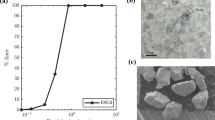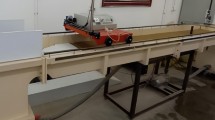Abstract
Flow-type landslide, such as debris-flow, often exhibits high velocity and long run-out distance. Simulation on it benefits the propagation analysis and provides solution for risk assessment and mitigation design. Previous studies commonly used shallow water assumption to simulate this phenomenon, ignoring the information in vertical direction, and the Bingham model to describe constitutive law of non-Newtonian fluid can cause numerical divergence unless necessary parameter is defined. To address the issue, the full Navier–Stokes equations are adopted to describe the dynamics of the flow-type landslides. Additionally, the general Cross model is employed as the constitutive model, which ensures the numerical convergence. Rheological parameters are introduced from the Bingham model and the Mohr–Coulomb yield criterion. Subsequently, the governing equations incorporating the modified rheological model are numerically built in the smoothed particle hydrodynamics (SPH) framework and implemented into the open-source DualSPHysics code. To illustrate its performance, the 2010 Yohutagawa debris-flow event in Japan is selected as a case study. Parameters regarding the debris magnitude, i.e., the front velocity and section discharge, were also well analyzed. Simulated mass volume and deposition depth at the alluvial fan are in good agreements with the in situ observation. On the basis of the results, the developed method performs well to reproduce the debris-flow process and also benefits the analysis of flow characteristics, affected area for risk assessment and mitigation design.









Similar content being viewed by others
References
Ancey C (2007) Plasticity and geophysical flows: a review. J Nonnewton Fluid Mech 142:4–35. doi:10.1016/j.jnnfm.2006.05.005
Barnes HA, Hutton JF, Walters K (1989) An introduction to rheology. Rheology series 3. Elsevier, Oxford
Berti M, Simoni A (2007) Prediction of debris flow inundation areas using empirical mobility relationships. Geomorphology 90:144–161. doi:10.1016/j.geomorph.2007.01.014
Berti M, Genevois R, Simoni A, Tecca PR (1999) Field observations of a debris flow event in the Dolomites. Geomorphology 29:265–274. doi:10.1016/S0169-555x(99)00018-5
Cascini L, Cuomo S, Pastor M, Sorbino G, Piciullo L (2012) Modeling of propagation and entrainment phenomena for landslides of the flow-type: the May 1998 case study. In: Proceedings of 11th international symposium on landslides: landslides and engineered slopes, Banf, Canada June, 2012. pp 3–8
Cascini L, Cuomo S, Pastor M (2013) Inception of debris avalanches: remarks on geomechanical modelling. Landslides 10:701–711. doi:10.1007/s10346-012-0366-0
Cascini L, Cuomo S, Pastor M, Sorbino G, Piciullo L (2014) SPH run-out modelling of channelised landslides of the flow-type. Geomorphology 214:502–513. doi:10.1016/j.geomorph.2014.02.031
Chen H, Lee C (2000) Numerical simulation of debris flows. Can Geotech J 37:146–160. doi:10.1139/Cgj-37-1-146
Cola S, Calabrò N, Pastor M (2008) Prediction of the flow-like movements of Tessina landslide by SPH model. In: Proceedings of the 10th international symposium on landslide and engineering slopes, Xi’an, China, 2008. pp 647–653
Corominas J (1996) The angle of reach as a mobility index for small and large landslides. Can Geotech J 33:260–271
Crespo A, Dominguez J, Rogers B, Gomez-Gesteira M, Longshaw S, Canelas R, Vacondio R, Barreiro A, Garcia-Feal O (2015) DualSPHysics: Open-source parallel CFD solver based on smoothed particle hydrodynamics (SPH). Comput Phys Comm 187:204–216
Crespo AC, Dominguez JM, Barreiro A, Gómez-Gesteira M, Rogers BD (2011) GPUs, a new tool of acceleration in CFD: efficiency and reliability on smoothed particle hydrodynamics methods. PLoS One 6:e20685. doi:10.1371/journal.pone.0020685
Crosta G, Dal Negro P (2003) Observations and modelling of soil slip-debris flow initiation processes in pyroclastic deposits: the Sarno 1998 event. Nat Hazards Earth Syst Sci 3:53–69
Cuomo S, Pastor M, Cascini L, Castorino GC (2014) Interplay of rheology and entrainment in debris avalanches: a numerical study. Can Geotech J 51:1318–1330. doi:10.1139/cgj-2013-0387
Dai Z, Huang Y, Cheng H, Xu Q (2014) 3D numerical modeling using smoothed particle hydrodynamics of flow-like landslide propagation triggered by the 2008 Wenchuan earthquake. Eng Geol 180:21–33. doi:10.1016/j.enggeo.2014.03.018
Dalrymple R, Rogers B (2006) Numerical modeling of water waves with the SPH method. Coast Eng 53:141–147. doi:10.1016/j.coastaleng.2005.10.004
Fannin R, Wise M (2001) An empirical-statistical model for debris flow travel distance. Can Geotech J 38:982–994
Fell R, Corominas J, Bonnard C, Cascini L, Leroi E, Savage WZ (2008) Guidelines for landslide susceptibility, hazard and risk zoning for land-use planning. Eng Geol 102:99–111
Frigaard I, Nouar C (2005) On the usage of viscosity regularisation methods for visco-plastic fluid flow computation. J Nonnewton Fluid Mech 127:1–26. doi:10.1016/j.jnnfm.2005.01.003
Gingold RA, Monaghan JJ (1977) Smoothed particle hydrodynamics: theory and application to non-spherical stars. Mon Not R Astron Soc 181:375–389
Gotoh H, Shao S, Memita T (2004) SPH-LES model for numerical investigation of wave interaction with partially immersed breakwater. Coast Eng J 46:39–63. doi:10.1142/S0578563404000872
Hadush S, Yashima A, Uzuoka R (2000) Importance of viscous fluid characteristics in liquefaction induced lateral spreading analysis. Comput Geotech 27:199–224. doi:10.1016/S0266-352x(00)00015-X
Hammad K, Vradis G (1994) Flow of a non-Newtonian Bingham plastic through an axisymmetric sudden contraction: effects of Reynolds and yield numbers. Numer Method Non-Newton Fluid Dyn ASME 179:63-69
Han Z, Chen G, Li Y, Zheng L, Zhang Y, Xu L (2013) A numerical simulation of volumetric enlargement for seismic debris flow using integrated DDA and KANAKO 2D. In: Frontiers of Discontinuous Numerical Methods and Practical Simulations in Engineering and Disaster Prevention. CRC Press, pp 281–287
Han Z, Chen G, Li Y, Xu L, Zheng L, Zhang Y (2014a) A new approach for analyzing the velocity distribution of debris flows at typical cross-sections. Nat Hazards 74:2053–2070. doi:10.1007/s11069-014-1276-3
Han Z, Chen G, Li Y, Zhang H, He Y (2014b) Elementary analysis on the bed-sediment entrainment by debris flow and its application using the TopFlowDF model. Geomat Nat Hazards Risk. doi:10.1080/19475705.2014.966868
Han Z, Chen G, Li Y, Tang C, Xu L, He Y, Huang X, Wang W (2015) Numerical simulation of debris-flow behavior incorporating a dynamic method for estimating the entrainment. Eng Geol 190:52–64. doi:10.1016/j.enggeo.2015.02.009
Hosseini S, Manzari M, Hannani S (2007) A fully explicit three-step SPH algorithm for simulation of non-Newtonian fluid flow. Int J Numer Meth Heat Fluid Flow 17:715–735. doi:10.1108/09615530710777976
Huang Y, Dai Z (2014) Large deformation and failure simulations for geo-disasters using smoothed particle hydrodynamics method. Eng Geol 168:86–97. doi:10.1016/j.enggeo.2013.10.022
Huang Y, Zhang W, Mao W, Jin C (2011) Flow analysis of liquefied soils based on smoothed particle hydrodynamics. Nat Hazards 59:1547–1560. doi:10.1007/s11069-011-9851-3
Huang Y, Zhang W, Xu Q, Xie P, Hao L (2012) Run-out analysis of flow-like landslides triggered by the Ms 8.0 2008 Wenchuan earthquake using smoothed particle hydrodynamics. Landslides 9:275–283. doi:10.1007/s10346-011-0285-5
Hungr O, McDougall S (2009) Two numerical models for landslide dynamic analysis. Comput Geosci 35:978–992. doi:10.1016/j.cageo.2007.12.003
Hungr O, Evans S, Bovis M, Hutchinson J (2001) A review of the classification of landslides of the flow-type. Environ Eng Geosci 7:221–238
Iverson RM (1997) The physics of debris flows. Rev Geophys 35:245–296. doi:10.1029/97rg00426
Jakob M (2005) Debris-flow hazard analysis. In: Jakob M, Hungr O (eds) Debris-flow hazards and related phenomena. Springer, Berlin, pp 411–443
Komatina D, Jovanovic M (1997) Experimental study of steady and unsteady free surface flows with water-clay mixtures. J Hydraul Res 35:579–590
Laigle D, Lachamp P, Naaim M (2007) SPH-based numerical investigation of mudflow and other complex fluid flow interactions with structures. Comput Geosci 11:297–306. doi:10.1007/s10596-007-9053-y
Lee E-S, Moulinec C, Xu R, Violeau D, Laurence D, Stansby P (2008) Comparisons of weakly compressible and truly incompressible algorithms for the SPH mesh free particle method. J Comput Phys 227:8417–8436. doi:10.1016/j.jcp.2008.06.005
Liu M, Liu G (2010) Smoothed particle hydrodynamics (SPH): an overview and recent developments. Arch Comput Methods Eng 17:25–76. doi:10.1007/s11831-010-9040-7
Liu X, Lin P, Shao S (2014) An ISPH simulation of coupled structure interaction with free surface flows. J Fluids Struct 48:46–61. doi:10.1016/j.jfluidstructs.2014.02.002
Lucy LB (1977) A numerical approach to the testing of the fission hypothesis. Astron J 82:1013–1024
Major JJ (1997) Depositional processes in large-scale debris-flow experiments. J Geol 105:345–366
McDougall S, Hungr O (2004) A model for the analysis of rapid landslide motion across three-dimensional terrain. Can Geotech J 41:1084–1097. doi:10.1139/T04-052
Medina V, Hürlimann M, Bateman A (2008) Application of FLATModel, a 2D finite volume code, to debris flows in the northeastern part of the Iberian Peninsula. Landslides 5:127–142. doi:10.1007/s10346-007-0102-3
Molteni D, Colagrossi A (2009) A simple procedure to improve the pressure evaluation in hydrodynamic context using the SPH. Comput Phys Commun 180:861–872. doi:10.1016/j.cpc.2008.12.004
Monaghan JJ (1988) An introduction to SPH. Comput Phys Commun 48:89–96. doi:10.1016/0010-4655(88)90026-4
Monaghan JJ (1992) Smoothed particle hydrodynamics. Ann Rev Astron Astrophys 30:543–574. doi:10.1146/annurev.aa.30.090192.002551
Morris JP, Fox PJ, Zhu Y (1997) Modeling low Reynolds number incompressible flows using SPH. J Comput Phys 136:214–226. doi:10.1006/jcph.1997.5776
Naili M, Matsushima T, Yamada Y (2005) A 2D Smoothed Particle Hydrodynamics method for liquefaction induced lateral spreading analysis. J Appl Mech 8:591–599
O’brien J, Julien P, Fullerton W (1993) Two-dimensional water flood and mudflow simulation. J Hydraul Eng 119:244–261
Osozawa S, Morimoto J, Flower MF (2009) “Block-in-matrix” fabrics that lack shearing but possess composite cleavage planes: a sedimentary mélange origin for the Yuwan accretionary complex in the Ryukyu island arc, Japan. Geol Soc Am Bull 121:1190–1203
Pastor M, Haddad B, Sorbino G, Cuomo S, Drempetic V (2009) A depth-integrated, coupled SPH model for flow-like landslides and related phenomena. Int J Numer Anal Meth Geomech 33:143–172. doi:10.1002/nag.705
Pastor M et al (2014) Application of a SPH depth-integrated model to landslide run-out analysis. Landslides 11:1–20. doi:10.1007/s10346-014-0484-y
Rickenmann D (1999) Empirical relationships for debris flows. Nat Hazards 19:47–77. doi:10.1023/A:1008064220727
Scheidl C, Rickenmann D (2010) Empirical prediction of debris-flow mobility and deposition on fans. Earth Surf Proc Land 35:157–173. doi:10.1002/esp.1897
Shao S (2010) Incompressible SPH flow model for wave interactions with porous media. Coast Eng 57:304–316. doi:10.1016/j.coastaleng.2009.10.012
Shao S, Lo EY (2003) Incompressible SPH method for simulating Newtonian and non-Newtonian flows with a free surface. Adv Water Resour 26:787–800. doi:10.1016/S0309-1708(03)00030-7
Sosio R, Crosta G, Frattini P (2007) Field observations, rheological testing and numerical modelling of a debris-flow event. Earth Surf Proc Land 32:290–306. doi:10.1002/esp.1391
Takahashi T, Nakagawa H, Harada T, Yamashiki Y (1992) Routing debris flows with particle segregation. J Hydraul Eng 118:1490–1507. doi:10.1061/(Asce)0733-9429(1992)118:11(1490)
Tang C, Rengers N, van Asch TW, Yang Y, Wang G (2011) Triggering conditions and depositional characteristics of a disastrous debris flow event in Zhouqu city, Gansu Province, northwestern China. Nat Hazards Earth Syst Sci 11:2903–2912. doi:10.5194/nhess-11-2903-2011
Wang G, Sassa K, Fukuoka H (2003) Downslope volume enlargement of a debris slide–debris flow in the 1999 Hiroshima, Japan, rainstorm. Eng Geol 69:309–330. doi:10.1016/S0013-7952(02)00289-2
WU J, Chen G, Zheng L, Zhang Y (2013) GIS-based numerical modelling of debris flow motion across three-dimensional terrain. J Mt Sci 10:522–531. doi:10.1007/s11629-013-2486-y
Acknowledgments
We would like to thank the DualSPHysics team who developed the open-source SPH code and provided it to the public. This study has received support from Kyushu University Interdisciplinary Programs in Education and Projects in Research Development and Grant-in-Aid for challenging Exploratory Research (15K12483, G. Chen) from Japan Society for the Promotion of Science. Also, this work was supported by the Foundation of State Key Laboratory of Geo-hazard Prevention and Geo-environment Protection (SKLGP2015K008). Finally, the authors greatly appreciate the careful review and thoughtful suggestions by the anonymous reviewers.
Author information
Authors and Affiliations
Corresponding author
Rights and permissions
About this article
Cite this article
Wang, W., Chen, G., Han, Z. et al. 3D numerical simulation of debris-flow motion using SPH method incorporating non-Newtonian fluid behavior. Nat Hazards 81, 1981–1998 (2016). https://doi.org/10.1007/s11069-016-2171-x
Received:
Accepted:
Published:
Issue Date:
DOI: https://doi.org/10.1007/s11069-016-2171-x




